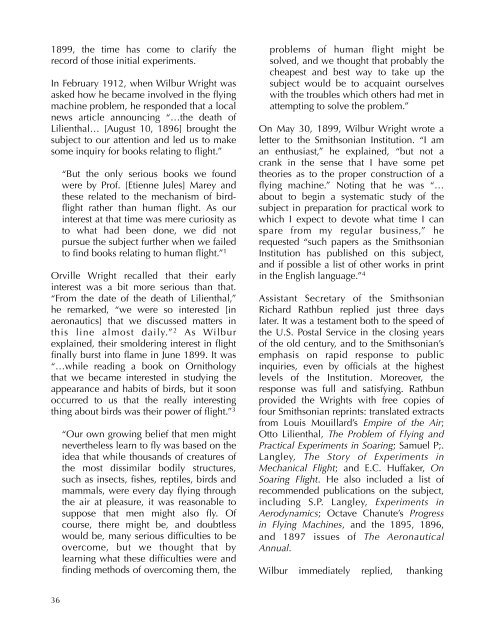Create successful ePaper yourself
Turn your PDF publications into a flip-book with our unique Google optimized e-Paper software.
1899, the time has come to clarify the<br />
record of those initial experiments.<br />
In February 1912, when Wilbur Wright was<br />
asked how he became involved in the flying<br />
machine problem, he responded that a local<br />
news article announcing “…the death of<br />
Lilienthal… [August 10, 1896] brought the<br />
subject to our attention and led us to make<br />
some inquiry for books relating to flight.”<br />
“But the only serious books we found<br />
were by Prof. [Etienne Jules] Marey and<br />
these related to the mechanism of birdflight<br />
rather than human flight. As our<br />
interest at that time was mere curiosity as<br />
to what had been done, we did not<br />
pursue the subject further when we failed<br />
to find books relating to human flight.” 1<br />
Orville Wright recalled that their early<br />
interest was a bit more serious than that.<br />
“From the date of the death of Lilienthal,”<br />
he remarked, “we were so interested [in<br />
aeronautics] that we discussed matters in<br />
this line almost daily.” 2 As Wilbur<br />
explained, their smoldering interest in flight<br />
finally burst into flame in June 1899. It was<br />
“…while reading a book on Ornithology<br />
that we became interested in studying the<br />
appearance and habits of birds, but it soon<br />
occurred to us that the really interesting<br />
thing about birds was their power of flight.” 3<br />
“Our own growing belief that men might<br />
nevertheless learn to fly was based on the<br />
idea that while thousands of creatures of<br />
the most dissimilar bodily structures,<br />
such as insects, fishes, reptiles, birds and<br />
mammals, were every day flying through<br />
the air at pleasure, it was reasonable to<br />
suppose that men might also fly. Of<br />
course, there might be, and doubtless<br />
would be, many serious difficulties to be<br />
overcome, but we thought that by<br />
learning what these difficulties were and<br />
finding methods of overcoming them, the<br />
problems of human flight might be<br />
solved, and we thought that probably the<br />
cheapest and best way to take up the<br />
subject would be to acquaint ourselves<br />
with the troubles which others had met in<br />
attempting to solve the problem.”<br />
On May 30, 1899, Wilbur Wright wrote a<br />
letter to the Smithsonian Institution. “I am<br />
an enthusiast,” he explained, “but not a<br />
crank in the sense that I have some pet<br />
theories as to the proper construction of a<br />
flying machine.” Noting that he was “…<br />
about to begin a systematic study of the<br />
subject in preparation for practical work to<br />
which I expect to devote what time I can<br />
spare from my regular business,” he<br />
requested “such papers as the Smithsonian<br />
Institution has published on this subject,<br />
and if possible a list of other works in print<br />
in the English language.” 4<br />
Assistant Secretary of the Smithsonian<br />
Richard Rathbun replied just three days<br />
later. It was a testament both to the speed of<br />
the U.S. Postal Service in the closing years<br />
of the old century, and to the Smithsonian’s<br />
emphasis on rapid response to public<br />
inquiries, even by officials at the highest<br />
levels of the Institution. Moreover, the<br />
response was full and satisfying. Rathbun<br />
provided the Wrights with free copies of<br />
four Smithsonian reprints: translated extracts<br />
from Louis Mouillard’s Empire of the Air;<br />
Otto Lilienthal, The Problem of Flying and<br />
Practical Experiments in Soaring; Samuel P;.<br />
Langley, The Story of Experiments in<br />
Mechanical Flight; and E.C. Huffaker, On<br />
Soaring Flight. He also included a list of<br />
recommended publications on the subject,<br />
including S.P. Langley, Experiments in<br />
Aerodynamics; Octave Chanute’s Progress<br />
in Flying Machines, and the 1895, 1896,<br />
and 1897 issues of The Aeronautical<br />
Annual.<br />
Wilbur immediately replied, thanking<br />
36


